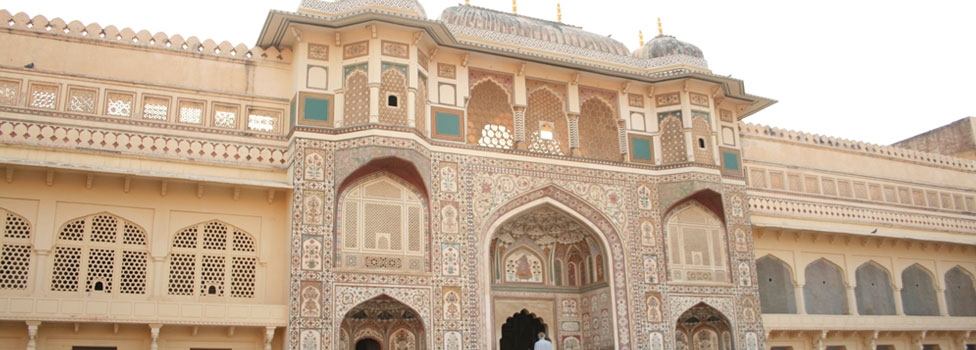The fort palace of Amber was the Kachhawaha citadel until 1727, when their capital moved to Jaipur. Successive rulers continued to come here on important occasions to seek the blessings of the family deity, Shila Devi. The citadel was established in 1592 by Man Singh I on the remains of an old 11th century fort, but the various buildings added by Jain Singh I are what constitute its magnificent centerpiece.
Exploring Amber
Crowning the crest of a hill, Amber Fort offers a panoramic view of Maota Lake and the historic old town at the base of the hill, which was the early seat of the Amber kings before they made the fort their capital. Several havelis, step wells, and temples can be seen below the fort, pointing to the existence of a self-sufficient township, where the Mughal emperor Akbar used to stop on his annual pilgrimage to Ajmer.
The Fort Complex
The main entrance to the historic Amber Fort is through the imposing Suraj Pol, so called because it faces the direction of the rising sun, the Kachhawaha family emblem. The gate leads into a huge courtyard, Jaleb Chowk, lined on three sides with souvenir and refreshment shops. A flight of steps leads to the Shila Devi Temple, which has silver doors; silver oil lamps, grand pillars carved to look like banana trees, and contain the Kachhawaha family deity, a stone image of the goddess Kali. The next courtyard is the Diwan-i-Aam, the space for public audience. Near it is the Sattais Katcheri, a colonnade of 27 pillars, where scribes once sat to record revenue petitions.
The magnificent Ganesh Pol is the gateway to three pleasure palaces, each with special features, built around a Mughal-style garden, Aram Bagh. Maota Lake, which provided water to the fort, is surrounded by two exquisite gardens. The Kesar Kyari Bagh has start-shaped flower beds once planted with saffron, flowers, while Dilaram Bagh, built in 1568 as a resting place for Akbar on his way to Ajmer, is a clever pun on the name of its architect, Dilaram. A small archeological Museum is located nearby. The farthest and oldest end of the fort was converted into the zenana, with screens and covered balconies for the seclusion of the royal ladies in purdah. Faint traces of frescoes are still visible on the walls. In the centre of the courtyard is a pavilion with 12 pillars, the Baradari.
The Township
The Chand Pol directly opposite Suraj Pol leads to the old town outside the fort. The beautiful Jagat Shiromani Temple with its remarkable torana is one of the many temples that lie along this route. It also has a water tank, Panna Mian ka Kund. To the east lies Sagar, a popular picnic spot with two terraced lakes. The Jaipur-Delhi Highway cuts across the town, and Amber’s main market and bus stand are located on this road. Further north stands the Akbari Mosque, built by Emperor Akbar in 1569, and towards the east is Bharmal ki Chhatri, a walled enclosure containing a group of memorials. This was the old cremation site for the rulers of Amber until a new spot was chosen at Gaitor, near Jaipur.
How to reach the Amber Fort
By Air
Jaipur’s Sanganer Airport is just south of the city.
By Rail
Jaipur Station well connected to Delhi by Ajmer Shatabdi and Delhi-Jaipur Express, to Mumbai by the Bombay Central-Jaipur and Aravalli expresses, and to Kolkata by the Howrah-Jaipur Express.
By Road
NH8 links Jaipur to Delhi via Shahpura and Dharuhera, and to Mumbai via Ajmer, Udaipur, Ahmedabad, Baroda, Bharuch, Pardi, Talasari and Manor. RSRTC operates deluxe coaches from Bikaner House in Delhi near Pandara Road. Excellent bus connections are also available from Jaipur’s Sindhi Camp Central Bus Terminal to other destinations in Rajasthan and beyond.
Amber Fort, Jaipur


